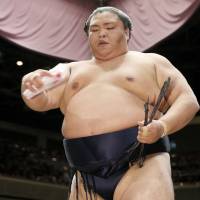The number of sumo wrestlers rises and falls as the popularity of the sport waxes and wanes.
Right now it's just shy of 700 men, but only those in the top two divisions are considered true professionals.
They are known as sekitori and account for just 10 percent of all wrestlers in the Japan Sumo Association.
Sekitori receive a salary, can get married, are allowed to move out of their stable, and generally live a far more comfortable life than the rikishi in the lower four divisions.
The difference is in fact so great, it's often referred to as "heaven and hell."
Those ranked below the second tier juryo division are little better than indentured servants. Wrestlers face a harsh existence with no salary and few freedoms.
Those who reach sekitori get one or two lower rankers as their personal attendants; Yokozuna may get four to six. They are the entourage you see trailing behind Hakuho, Kisenosato and other titans of the dohyo.
Sekitori are easily differentiated during tournaments. While lower-ranked wrestlers must fight in the same black canvas belts used for training, sekitori use brightly colored silk.
Sumo regulations technically only allow a color close to Prussian Blue, but this rule is widely ignored and you can see green, pink, yellow red and other belt colors in the ring.
A sekitori's various income streams would need a background in forensic accountancy to understand, but the most visible for those in the top division is the bundle of cash-filled envelopes given to winners of certain bouts.
Sekitori who are talented or popular see many of those envelopes, which are essentially sponsorship money. Generous sekitori — or those who remember the uncompensated grind of their amateur days — often spend that money on their assistants.



